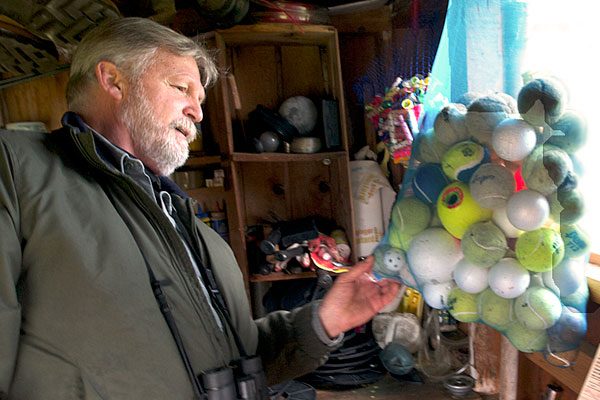By ROSS COYLE
Sequim Gazette
An air of mystery surrounds the island north of Discovery Bay, nestled between the western shore of Port Townsend and the eastern shore of Sequim. Signs surround it, warning visitors to stay 200 feet away from the shore. Even aircraft are barred from breaching the 2,000 foot no fly zone. Residents and visitors view Protection Island as an enigma.
Access is restricted to the island, which has had a colorful history before it became a wildlife refuge.
Discovered by Juan de Fuca in 1790, it was officially named by George Vancouver in 1792. Later, Abraham Lincoln ceded the land for farming to four families as thanks for their service in the War of 1812.
In the early 1900s it almost become a leper colony, then a housing development, before its final classification as a wildlife refuge by the U.S. Department of Fish and Wildlife.
Now, only one regular inhabitant, Marty Bluewater, is the last of nine families who were granted extended use permits when the island’s protections were established in the 1980s.
Bluewater won’t leave his land to his descendants. After his death, the government will pick up his property to turn the island into a completely self-enclosed wildlife sanctuary. But even after the end of human development, a few rare individuals will live on it — the caretakers. The island’s volunteer caretakers live for six months out on the island in a small A-frame, almost completely isolated from the rest of the world, save for a cell phone, satellite Internet and a boat to return to the mainland.
The house is powered by two gasoline generators and solar cells. A gasoline powered generator pumps water from the island’s well to a 3,000-gallon water tower. While the water isn’t potable – caretakers supply their own fresh water – it can still be used for washing. Apart from the living space, Fish and Wildlife also provides caretakers with a $350 per month stipend to buy supplies.
Master Mariner Lew Brantley volunteers as a caretaker on the island, keeping people outside the 200-yard exclusion zone, maintaining the machinery and picking up beach debris from fisheries and other marine activities. In his work, he’s started collecting an assortment of baseballs, tennis balls, golf balls and any other balls that might wash up on the shore.
“Just one more element of the tremendous amount of garbage that washes up on the shores,” he said.
A maritime retiree from Alaska, Brantley volunteered as a caretaker to help stay active in his older years.
“I really feel like you gotta get out and do things,” he said, not wanting to let the years when he has the most time to slip by unused.
While retirement for many people is a time to slow down, Brantley sees it as the best time to do whatever he wants. “I used to get coffee at the QFC with the old timers who said ‘Next year I’m going to get a motorhome and see my daughter out in Minnesota,’ and they gradually turned into ‘I sure wish I had gotten out to do that.’”
Island routines
Life on the island is a pioneer lifestyle of modest means, but Brantley says that the natural immersion is hard to beat. Each morning, he wakes up to the sunrise over Port Townsend and goes to bed as the moon reflects over Discovery Bay. During the day, he roams the island to check on the beaches and pick up hazards or pollutants. Their isolated work forces them to be self-reliant and mobile. “I carry my backpack with day and night flares and signaling devices and I never go anywhere on the island without them,” say Brantley. On these check-up hikes, he also gets to see the island’s wildlife up close.
The island is home to dozens of different species including deer, harbor and elephant seals, squirrels, the rare rhinoceros auklet, bald eagles, northern harriers, peregrine falcons and puffins. During the summers, he says that up to 400 harbor seals make their homes on the beaches and thousands of seagulls inhabit the island’s cliffs. The deer, all named Larry, graze openly in his backyard, and two chipmunks, Hank and Dusty, keep their bachelor pad underneath his deck. As he walks along the beaches, land otters climb out of the sea and play behind him. When he turns to look at them, they freeze. He turns back to his walk and they resume their antics.
The life is lonely but also very serene and peaceful, Brantley noted at the water tower which overlooks the island. “It’s a place to reflect, that’s for sure.” The quiet lifestyle lets him recharge and reset away from the worries of the world. “Your energy level goes up when you come back to civilization,” he said. “I’m really appreciative to have this opportunity.”
Calling caretakers
Anyone is welcome to become a full-time volunteer caretaker, Brantley said, although the department looks for people with wildlife or marine backgrounds, such as former boat captains and wildlife researchers. While they take a position at the island for six months, they still have the liberty to return home as the tides allow it. In Brantley’s case, he goes home to Coupeville every two weeks to restock supplies and check on his house. The distance to town stresses the importance of planning his two-week stay on the island.
“You gotta plan ahead of time what you’re going to have,” he said, “because if you get out there and you don’t have it, you can’t go back to get it.”
After going through two volunteer shifts on the island, Brantley is contemplating signing up for a third, but he’s not certain. There’s still a lot to do in his retirement years.
Contact Ross Coyle at rcoyle@sequimgazette.com.



